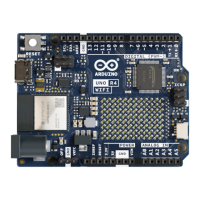Features
The R7FA4M1AB3CFM#AA0, often referred to as RA4M1 in this datasheet, is the main MCU on the UNO R4 WiFi,
connected to all pin headers on the board as well as all communication buses.
Overview
48 MHz Arm® Cortex®-M4 microprocessor with a floating point unit (FPU)
5 V operating voltage
Real-time Clock (RTC)
Memory Protection Unit (MPU)
Digital-to-analog Converter (DAC)
Memory
256 kB Flash Memory
32 kB SRAM
8 kB Data Memory (EEPROM)
Peripherals
Capacitive Touch Sensing Unit (CTSU)
USB 2.0 Full-Speed Module (USBFS)
14-bit ADC
Up to 12-bit DAC
Operational Amplifier (OPAMP)
Power
Operating voltage for RA4M1 is 5 V
Recommended input voltage (VIN) is 6-24 V
Barrel jack connected to VIN pin (6-24 V)
Power via USB-C® at 5 V
Communication
1x UART (pin D0, D1)
1x SPI (pin D10-D13, ICSP header)
1x I2C (pin A4, A5, SDA, SCL)
1x CAN (pin D4, D5, external transceiver is required)
See the full datasheet for the R7FA4M1AB3CFM#AA0 in the link below:
R7FA4M1AB3CFM#AA0 datasheet
The ESP32-S3-MINI-1-N8 is the secondary MCU with a built-in antenna for Wi-Fi® & Bluetooth® connectivity. This
module operates on 3.3 V and communicates with the RA4M1 using a logic level translator (TXB0108DQSR).
Overview
Xtensa® dual-core 32-bit LX7 microprocessor
3.3 V operating voltage
40 MHz crystal oscillator

